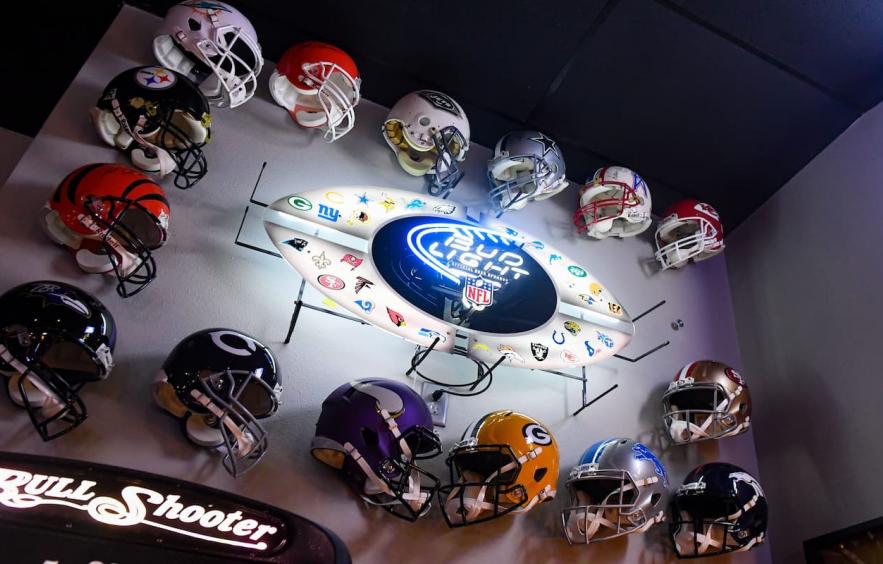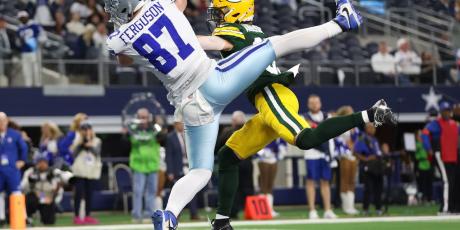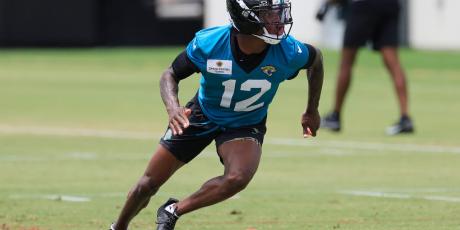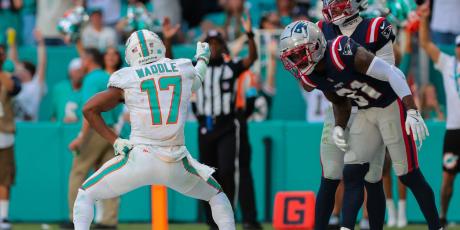How to Dominate 2024 Salary Cap Drafts (Tips & Tricks)

Have you suffered emotional distress at the hands of a fantasy manager snatching your draft picks one spot before you? Never had a chance to draft Christian McCaffrey because you always get the last pick? Been forced to start Desmond Ridder after a run on quarterbacks left you without options in a two-QB league (... definitely not a personal horror story …)?
You may be entitled to compensation … in the form of a salary cap draft!
That’s right, while most fantasy football players use the tried and true “snake draft” format, some of us (degenerates) have been riding the thrilling roller coaster of salary cap drafts for years. Just the unadulterated fairness of a $200 bankroll and your wits.
And yet, salary cap drafts can be intimidating. They’re so different, and so nuanced, that many fantasy fans are hesitant to take the plunge. That’s what this article is here for. We’re going to blaze through everything you need to know about the format, how to approach your draft, the strategies, tips, and tricks to give you an edge, and more. In about 4,000 words, you’ll be equipped to dive into a salary cap draft without fear and come out the other side with a championship roster.
Related: Analyzing a 2024 Salary Cap Mock Draft (July)
Fantasy Football Salary Cap Strategies
While salary cap leagues come in all shapes and sizes, the most common will be a typical roster — one QB, a couple RBs and WRs, one TE, a FLEX or two, several bench spots, etc. — with a $200 budget. We’ll use that baseline throughout this article, but just remember that if the budget in your league is different, the relevant strategies remain the same on a percentage basis.
Unlike in a snake draft — where the manager with the 1.01 gets to choose their favorite player, with zero input from anyone else in the league, and so on down the line — salary cap drafts work with a “nomination-and-bid” system. Each manager nominates a player and the entire league has a chance to acquire him through the ensuing bidding war. The highest bidder when the clock runs out gets to draft that player.
This methodology creates a wide swath of viable approaches or strategies. We saw several of them play out in a salary cap mock draft I ran and analyzed in early July, which I’ll reference often below. Let’s take a look at a few of the most prominent:
“Studs & Scrubs”
The Studs & Scrubs strategy is where salary cap drafts really stand out from your typical snake. You want both Christian McCaffrey and CeeDee Lamb? It will probably take 60-65% of your budget just to snag those two guys, but it’s absolutely doable.
In our July mock, one manager grabbed Bijan Robinson, Tyreek Hill, and Amon-Ra St. Brown for $143 of their $200 budget. That’s the 1.03, 1.06, and 1.08 in snake draft ADP. A complete impossibility in your typical league, executed with ease in a salary cap draft.
Of course, by committing 75% of your budget to an elite core early on, you will likely end up filling out your starting lineup (and bench) with late-round sleepers or waiver fodder. Hence the “Scrubs” in the strategy’s name. That team that got Robinson, Hill, and St. Brown in our mock ended up with Keaton Mitchell as their RB2 and guys like Jahan Dotson and Braelon Allen at the back of their bench.
One of the defining pieces of this strategy is a willingness to overspend (a little) on those top players. While other strategies might focus on finding value in every pick, the Studs & Scrubs approach cares more about the players at the top and might involve a few bids past your ideal “target price” to acquire those guys.
Either way, you’re going to have to be patient through the middle rounds (when most of the league will outbid you for every relevant player) and then hammer sleepers and upside picks late. In particular, target young wideouts who could earn a lead role sooner than later, running backs that could ascend to the top of a murky depth chart, and most likely a $1-4 quarterback like Jared Goff or Tua Tagovailoa.
Pros:
- If your elite core stays healthy, you’ll have an upside edge over the rest of the league.
- Most championship-winning teams require one or two top-tier players. This approach can land you three or four of those guys from the jump.
- Between the unpredictability of the NFL and the power of the waiver wire, the latter half of most fantasy rosters looks completely different by Week 8 than it did after the draft. This strategy puts the emphasis where it matters (at the top) and expects to figure out the rest on the fly.
Cons:
- If your elite core doesn’t stay healthy, you’re going to be in pretty bad shape. The contingency plans you’d have with a typical snake draft or a more balanced salary cap strategy simply won’t exist, and you’ll likely end up at the bottom of the standings quicker than you can say “anterior cruciate ligament.”
- Even if they stay healthy, a few of the top players will end up busting each season. Austin Ekeler was drafted as the RB2 last year for around $65 and ended up being the RB28. A less top-heavy approach could have landed Travis Etienne (RB3) and Joe Mixon (RB5) with $10 to spare.
- If you don’t hit on sleepers or play the waiver wire successfully, it may be difficult to put together a winning lineup consistently, especially when your elite core has a down week.
“Patient Prowler”
If you’re less interested in landing multiple superstars, and more intent on building a deep squad, you may be a “Patient Prowler.” This strategy revolves around a slow start — avoiding the studs that typically dominate early nominations — and a “bully” tactic in the middle of the draft when most other managers are low on bankroll and you have the buying power to land whoever you want.
As we noted above, the Studs & Scrubs drafters will likely have spent 50-75% of their budget on their first few picks, and will still have at least a dozen players left to draft. That caps their ability to bid on the middle-tier players and gives the Patient Prowler free reign to compile a stable of solid RB2s and WR2s, along with a strong pick at quarterback, tight end, or both.
Consider my squad in the mock draft. I have Josh Allen at QB, Dalton Kincaid at TE, and the combos of Isiah Pacheco-Aaron Jones at RB and Garrett Wilson-DeVonta Smith at WR. Plus I have the weekly choice of Amari Cooper, George Pickens, Chris Godwin, and Zamir White at my FLEX. My fourth-best FLEX option is better than the Studs & Scrubs team’s RB2.
This approach is going to result in a squad much more likely to survive a tough injury or disappointing bust. And by casting a wider net on mid-tier talent, it also significantly increases your odds of finding massive value, i.e. players who go for less than $20 but turn out to be studs once the season starts. In 2023, D.J. Moore went for less than $15 and finished as the WR6. Isiah Pacheco went for less than $10 and was a high-end RB2. You’re simply not going to find value like that in the high-cost stars, since their upside is already baked into their price.
Additionally, this is the stretch where you’re most likely to see massive discounts on players. With depleted budgets across the draft, fatigue and distraction starting to set in, and several managers likely caught in the mental transition from superstar bidding wars to sleeper watch, you could easily steal a couple of guys for as low as half their projected value in this window of the draft.
Pros:
- These rosters will be more capable of weathering hardship, injury, busts, etc.
- In end-of-draft “value gained” analysis, these rosters are typically the ones that saw the most significant discounts, at least on a percentage basis.
- With a wealth of mid-tier guys in your pocket, you’re much more likely to enjoy the thrill of breakout value than the team who spent all their capital on known commodities priced at their ceilings.
- Because this strategy is more about capitalizing on the weaker wallets of managers in the middle rounds, it’s less likely you’ll get caught up in frustrating bidding wars or overspend out of stubborn commitment to a top-tier target player.
Cons:
- As we mentioned above, most championship rosters feature at least one or two studs by the end of the season. You can hope one or two of your discount players will break out into that stratosphere, but it’s less reliable than drafting CMC or CeeDee at the top.
- From a purely emotional and mental perspective, this approach takes a lot of patience and discipline. When the top 10 running backs and wide receivers are all gone and you have yet to place a bid, it’s easy for diligence to turn to desperation.
“Best Price Available”
If you’ve been around fantasy or real-life NFL football for any decent amount of time, you’ve likely heard the term “best player available” when it comes to draft strategy. The core of the idea is to simply take the highest-ranked or “best available” player every time you’re on the clock, rather than dropping down your draft board to fill positional holes, build a stack, snag someone you’re a fan of, etc.
In salary cap drafts, this is a non-starter, since you have an equal shot at every player — at least until your budget’s gone — but we can substitute a similar alternative with “Best Price Available.” Rather than focusing on roster construction, positional depth, budget allocation, etc., we can instead dictate our decisions on simply acquiring the best bang for our buck each and every time a player is nominated.
Pulling this strategy off takes a little extra preparation. You need to know not only the average value of each player (see my ADP vs Salary Cap Value chart below) but also how much you like each player and how discounted they’d have to be to earn your bid. Additionally, you have to be ready to adjust all those numbers as the draft goes on, based on how much of your budget is spent and how much of the league’s budget is spent. Let’s say Garrett Wilson is nominated, and after reaching $20, bidding slows to a halt. You know Wilson’s average value should be around $30-35, and while you’re not high on him, you’d still consider him a value up to $29. With the “Best Price Available” strategy, this is an ideal time to pounce, allowing you to potentially score a fringe WR1 at a discount.
The biggest key to this strategy is the on-the-fly adjustment. It’s all well and good to target value across the board, but if running back prices are inflated in your draft (like they were in the July mock), you might not ever get an RB if you don’t pivot accordingly. Additionally, the sharper your league mates are, the harder it’s going to be to pull this off successfully, as they’re more likely to bid players up to average value and less likely to let discounts slip through the cracks.
Pros:
- Of the strategies covered here, this is the one least likely to result in overspending and most likely to return overall bankroll value.
- Where both of the other strategies can result in bidding wars and weaknesses in roster construction, this one avoids confrontation and creates the best overall bang for your buck … if executed successfully.
Cons:
- This strategy is harder to pull off, simply due to the amount of knowledge and valuation dexterity you need to make it work from start to finish.
- If you wait too long hunting for the right values — especially if your target prices are askew — you’re likely to end up with a poor man’s version of the “Patient Prowler” team that suffers from lack of star power and lack of quality depth.
“The Instigator”
Where the “Best Price Available” strategy is about avoiding confrontation and sneakily accumulating value, “The Instigator” — as the name suggests — does the complete opposite. This strategy is all about nominating players that you don’t want but that will bankrupt your opponents and trying to bid up the prices on players who would otherwise go for a discount … without actually drafting them.
Let’s be clear: this strategy is volatile and not particularly keyed towards success … but it can be fun, especially in home leagues with close friends. The goal, of course, is to ensure your opponent’s budgets are as depleted as possible when you are ready to make your moves throughout the draft. Just be warned, bidding up a player you don’t really want might eventually result in acquiring a player you don’t really want, at a price you immediately regret. This strategy is risky and should be considered with caution.
Pros:
- When it works, it’s a ton of fun to tilt your league mates (particularly if you’re good friends) and can lighten the other wallets in the draft enough to grant you some solid value picks.
Cons:
- When it doesn’t work, it can result in a roster full of players you didn’t intend to acquire at regrettable prices.
Tips & Tricks
Here’s a comprehensive hit list of my favorite salary cap draft tips and tricks. The more of these you can successfully juggle during the draft, the closer you’ll finish to an ideal roster and a championship season.
Know the Values
Comfortably understanding average values for players is critical in salary cap drafts. Much like understanding ADP in a snake draft, it gives you a good concept of when, where, and how you can acquire a player. Importantly, there is less solid data to dictate the “average” or “recommended” prices you’ll see in online softwares, and if you’re participating in a live salary cap draft, there will be even less to go on.
On top of that, fantasy sites that include salary cap rankings can vary wildly from brand to brand. I pulled up three major sites to eyeball value and saw Garrett Wilson vary from $31 to $46, Jalen Hurts from $23 to $36, and Christian McCaffrey from $65 to $79. Ultimately, how you determine “average” or “consensus” value is up to you. You can calculate the averages of a few trusted sites, lock in the singular sample of one analyst you trust, or put together your own cheat sheet in the way you see fit.
Regardless of how you set the numbers, the important thing is that you set them. This will give you a barometer to work off of when the bidding wars ensue (which they will) and a useful understanding of value to guide your draft process. As part of the process of writing this article, I did a good amount of data mining and came up with the chart below to roughly translate ADP to salary cap value. You can use this chart to approximate the “average price” of a given player based on their current ADP (which means that it’s always “fully updated” since it works off of nameless numbers).

As you can see, salary cap values are extremely top-heavy, take a nosedive from the 1.01 through about the third round, and then decrease at a much more linear pace through the rest of the draft. Working off this chart, especially in conjunction with the aggregate ADP on 4for4.com, you can pick any player, identify their current ADP, and ballpark a fair correlating salary cap value. As a few examples, Derrick Henry (overall ADP of 17) should be about $32, Malik Nabers (51) should be about $17, and Brock Bowers (101) should be about $8. While those numbers might clash with the rankings-based values on any given site, they should offer a decent expectation for the average salary cap draft.
Know When to Ditch the Values
The key word in that last sentence was “average” — salary cap drafts, far more than their snake counterparts, are prone to divert completely off the rails in a hurry. In the article I wrote analyzing the July mock draft, there’s a whole section on how RB values were heavily inflated in that draft, and how reacting to that reality quickly can make or break a quality roster. When it takes $32 to acquire James Cook ($1 more than A.J. Brown) or $20 to snag Brian Robinson (the same cost as Josh Allen), you have to adjust accordingly.
If you have the tools (a pen and paper will do, an Excel/Google Sheet would be even better), track how much every player goes for and how much those numbers vary from your target/average values. Then use that data to adjust values for the rest of the draft. This will keep you from getting “price-locked,” which is arguably the most dangerous threat to a solid salary cap draft. If running backs are going for 30% more than you expected, be prepared to pay up for the guys you wanted or to take a “zero RB” approach and pivot to value at other positions. If quarterbacks are going for half their expected price, grab one of the elite few and bid a little extra to stack them with their top wideout.
Know Your League
Once again, this is a tip that should sound familiar to snake drafters, but is even more important in salary cap drafts. Because you have the power to affect every pick that is made, knowing the fandoms, sleeper picks, favorite analysts, etc. that influence your opponents’ decisions can have a much broader and deeper impact. If someone shows up in a CeeDee Lamb jersey, you can bet he’ll be willing to pay more than top dollar to draft him and you can probably run up the price.
Nominate With Intention
There are several strategies to nomination, and they should typically change throughout the draft. The most important lesson is to nominate with intention, rather than simply throwing out the top name on the board every time you’re up. Here are a few of the best moves when it comes to nomination approach:
- Nominate top-tier players you don’t like early on (but don’t be too obvious about it). Encouraging bidding wars over high-value targets that you don’t intend to draft is a tried and true method of depleting opponent bankrolls. Just make sure to throw a few bids in so your league mates don’t get wise. If you need some suggestions, look for the players that are higher in ADP but lower in our 4for4 rankings.
- Nominate your favorite player in a tier before he’s the last one left in that tier. It’s not uncommon for the last player in a tier to go for an inflated value, while his predecessors go at a discount because there are still “other fish in the sea.” If you really want Trey McBride, don’t wait until Sam LaPorta, Travis Kelce, Mark Andrews, and Dalton Kincaid are all gone.
- In the middle rounds, do not nominate your favorite draft targets … let someone else do it. If you’re the one putting Javonte Williams or Brian Thomas Jr. on the board, your league is likely to guess they’re a favorite sleeper of yours and run up the price. I like to apply this mindset to all of my favorite targets between $5-25 in expected value.
- In the late rounds, when players are going for just a dollar or two, switch to nominating your favorite sleepers, otherwise you risk getting stuck with someone you don’t want for a dollar. (Just be nonchalant about it.)
- If you fill a position (especially QB or TE), start nominating that position en masse until your league mates have done so as well. You’re taking funds out of their wallets at zero risk to yourself, opening up opportunities for discounts on the positions you still need.
Track the Remaining Budgets
It’s absolutely critical that you know how much remaining budget your opponents are working with, and what each of them needs. If the league mate with the largest bankroll an hour in is still without a QB, now is probably not the time to nominate your favorite pick at that position. Also, try to track each team’s maximum bid — i.e. their remaining bankroll + 1 - the number of positions they have left to fill. If someone with a max bid of $10 and an open WR2 slot nominates George Pickens, raising the bid to $11 will lock that manager out.
Capitalize on the Frenzies
If you see a bidding war over a player (e.g. Travis Etienne) that eventually results in an inflated value, nominate a similar player at the same position (e.g. Derrick Henry) immediately after. The preceding bidding war will likely affect the psyche of every other manager in the league, and they may rush to overpay in a similar fashion. This is a quick way to swing the economy of a salary cap draft in your favor … as long as you remain fluid and adjust accordingly.
Start the Run, Don’t Finish It
As in snake drafts, it’s always better to start a positional run than to finish it in salary cap drafts. If several big names at a certain position start flying off the board in quick succession, the picks at the end of that run are likely to be less valuable, as managers scramble to snag someone of value before the options dry up. Instead, grab your guy early in the run — usually for that “more fish in the sea” discount — and then watch with amusement as the rest of your opponents batter each other with their wallets.
Don’t Lose Your Cool
You’re going to lose a frustrating bidding war … or two or three. Don’t panic and don’t go on tilt. Unlike a snake draft, where you’re given a few minutes to cool off after getting “sniped,” and will face a relatively simple decision at your next pick, salary cap drafts require constant attention and level-headed decision-making throughout. If you lose your cool, it can very quickly bleed into a series of bad moves on ensuing nominations. Stay focused. Follow these tips. Profit.
Vary Your Bids to Catch Opponents Off Guard
Increasing the bid by $1 over and over has its merits. You might be able to frustrate the competition enough to turn them away. But more often than not, there’s a psychological drive to re-bid that $1 to retake the lead much further than you’d expect. Instead, throw in some “jump bids,” where you jack the price up by 30-40% of your intended target value in a single swoop. This can often catch your league mates off guard, and will sometimes result in slow reactions and a surprise discount. If A.J. Brown has been bid up from $1 to $15 in single-dollar increments, throw in a sudden $25 bid (still well below target value) and see what happens. You’d be surprised at the mistakes entire leagues can make out of inattentiveness in salary cap drafts.
Have a Budget for Starters vs Bench
While I don’t recommend setting a specific budget for every roster spot, or even position group, it’s helpful to know how much you want to spend on your starters and how much you intend to leave for your bench. This will give you a manageable target number to work with early in the draft, where you spend the majority of your budget on your most important players. In our July mock draft, the average six-player bench ended up costing $27, but the most common “build type” allocated closer to $15. Typically, I‘d aim to sink around 85-90% of your budget into your starters, leaving just a few dollars per bench slot (as backups and sleepers will mostly go for $1-5 anyway).

















